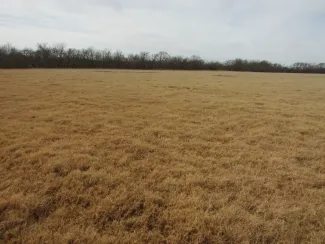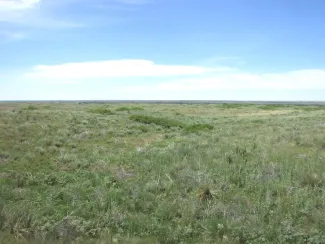Oklahoma's landscape bursts into color when spring conditions finally overtake the cold of winter. And while the native plants around us awaken to provide the food and cover that wildlife need, spring also awakens a sleeping giant – bermudagrass.

Bermudagrass fields offer very little year-round food and cover for wildlife and fail to provide habitat for species like bobwhite quail.
Despite being a non-native species, bermudagrass is certainly no stranger to Oklahoma. In fact, the Oklahoma Ecological System Mapping project revealed the grass was the most commonly encountered plant species across the state. Unfortunately, its substantial presence reduces the acres of native habitat that could attract and hold species like bobwhite quail.
But quail aren't the only species that are negatively affected when bermudagrass fields are planted or when the grass expands into native range. White-tailed deer, wild turkeys, mourning doves, cottontail rabbits, and a multitude of songbirds and other animals also avoid or sparingly use bermudagrass-dominated sites. Why? It all comes down to habitat quality. While well-managed native ranges generally excel at providing food and cover diversity for wildlife, the sod-like growth can, and usually does, outcompete native plants for space. Simply put, bermudagrass-dominated sites fail to provide the year-round food and cover requirements for nearly every wildlife species in Oklahoma.
What's a landowner to do if large areas of bermudagrass are no longer desired? The simple answer is to convert the acres back to native vegetation, including native wildflowers and warm season grasses. For those interested, the spring season brings about the perfect time to begin the process.

Diversity is the key to good wildlife habitat, especially an assorted and well-distributed mix of native grasses, wildflowers, and woody vegetation.
Bermudagrass is a tough and extremely resilient plant. It's important to note that converting acres back to native vegetation will take time. The plant has an extensive root system and a fast growth rate when conditions are suitable. This means that not every practice is likely to completely remove it; a combined approach is best.
In short, disking rarely kills bermudagrass and the plant will come back with a vengeance to, once again, take over whatever may have been planted in its place. Herbicide is usually required, and multiple sprayings per year are generally necessary. Sometimes multiple years of sprayings are also required, at least on a spot-treatment level. Removing the old thatch well ahead of the spraying is important to maximize the results, and this can be achieved by various ways such as burning or grazing.
For land managers on the edge of justifying a bermudagrass-to-native vegetation-conversion project, consider this. Two central Oklahoma habitats were surveyed, one dominated by bermudagrass and one a native range with scattered shrub thickets. Only six known quail food plants were identified within the introduced field, and the abundance of those food plants was very low. The native range habitat provided 54 known quail food plants, 11 of which were important, high use foods. And this comparison doesn't even consider the high quality year-round cover the native range provided compared to the extremely poor cover of the bermudagrass field. In addition to wildlife benefits, native rangeland may also offer grazing benefits for producers.
While converting bermudagrass fields to native vegetation may take some diligent work and a little patience, the decision can be relatively easy, especially for quail lovers.